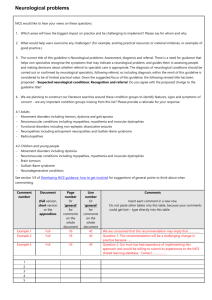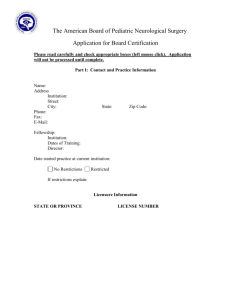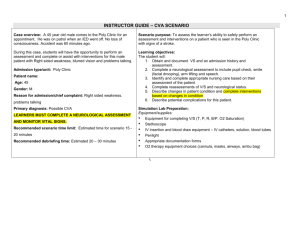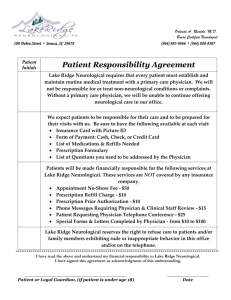Alzheimer`s disease and stroke carry highest costs
advertisement
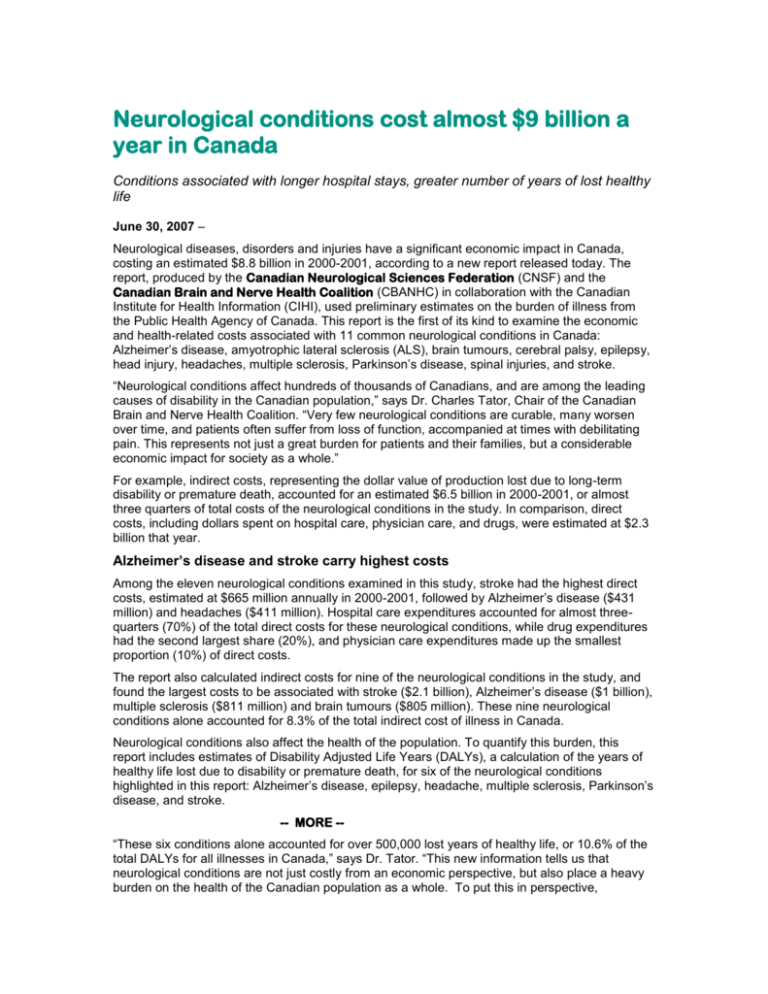
Neurological conditions cost almost $9 billion a year in Canada Conditions associated with longer hospital stays, greater number of years of lost healthy life June 30, 2007 – Neurological diseases, disorders and injuries have a significant economic impact in Canada, costing an estimated $8.8 billion in 2000-2001, according to a new report released today. The report, produced by the Canadian Neurological Sciences Federation (CNSF) and the Canadian Brain and Nerve Health Coalition (CBANHC) in collaboration with the Canadian Institute for Health Information (CIHI), used preliminary estimates on the burden of illness from the Public Health Agency of Canada. This report is the first of its kind to examine the economic and health-related costs associated with 11 common neurological conditions in Canada: Alzheimer’s disease, amyotrophic lateral sclerosis (ALS), brain tumours, cerebral palsy, epilepsy, head injury, headaches, multiple sclerosis, Parkinson’s disease, spinal injuries, and stroke. “Neurological conditions affect hundreds of thousands of Canadians, and are among the leading causes of disability in the Canadian population,” says Dr. Charles Tator, Chair of the Canadian Brain and Nerve Health Coalition. “Very few neurological conditions are curable, many worsen over time, and patients often suffer from loss of function, accompanied at times with debilitating pain. This represents not just a great burden for patients and their families, but a considerable economic impact for society as a whole.” For example, indirect costs, representing the dollar value of production lost due to long-term disability or premature death, accounted for an estimated $6.5 billion in 2000-2001, or almost three quarters of total costs of the neurological conditions in the study. In comparison, direct costs, including dollars spent on hospital care, physician care, and drugs, were estimated at $2.3 billion that year. Alzheimer’s disease and stroke carry highest costs Among the eleven neurological conditions examined in this study, stroke had the highest direct costs, estimated at $665 million annually in 2000-2001, followed by Alzheimer’s disease ($431 million) and headaches ($411 million). Hospital care expenditures accounted for almost threequarters (70%) of the total direct costs for these neurological conditions, while drug expenditures had the second largest share (20%), and physician care expenditures made up the smallest proportion (10%) of direct costs. The report also calculated indirect costs for nine of the neurological conditions in the study, and found the largest costs to be associated with stroke ($2.1 billion), Alzheimer’s disease ($1 billion), multiple sclerosis ($811 million) and brain tumours ($805 million). These nine neurological conditions alone accounted for 8.3% of the total indirect cost of illness in Canada. Neurological conditions also affect the health of the population. To quantify this burden, this report includes estimates of Disability Adjusted Life Years (DALYs), a calculation of the years of healthy life lost due to disability or premature death, for six of the neurological conditions highlighted in this report: Alzheimer’s disease, epilepsy, headache, multiple sclerosis, Parkinson’s disease, and stroke. -- MORE -“These six conditions alone accounted for over 500,000 lost years of healthy life, or 10.6% of the total DALYs for all illnesses in Canada,” says Dr. Tator. “This new information tells us that neurological conditions are not just costly from an economic perspective, but also place a heavy burden on the health of the Canadian population as a whole. To put this in perspective, neurological conditions represent a greater burden in terms of lost years of healthy life in Canada, than endocrine diseases, respiratory diseases, and digestive diseases.” Patients with neurological conditions have longer than average hospital stays In 2004-2005, about 180,000 patients with at least one of the 11 neurological conditions highlighted in this report had to spend at least one night in an acute care hospital in Canada. In fact, 9.3% of all hospitalizations in Canada were for patients with at least one of these 11 conditions. The median length of stay for patients with a neurological condition was 7 days, compared with an overall median of 4 days for all acute care patients. About CNSF The Canadian Neurological Sciences Federation (CNSF), formerly the Canadian Congress of Neurological Sciences (CCNS), is an organization representing four member societies: Canadian Neurological Society, Canadian Neurosurgical Society, Canadian Society of Clinical Neurophysiologists and the Canadian Association of Child Neurologists. CNSF’s mission is to enhance the care of patients with diseases of the nervous system through education, advocacy and improved methods of diagnosis, treatment and rehabilitation. About CBANHC The Canadian Brain and Nerve Health Coalition (CBANHC), established by the former CCNS, is a coalition of several voluntary health organizations and practitioners with an interest in neurological disorders. CBANCH is committed to improving the quality of life of Canadians by promoting access to cost-effective treatments, supporting research and education and promoting public and government awareness of the incidence and impact of nervous system disorders and injuries. - 30 Media contacts: Lisa Brazeau Cell: (613) 863-0667 The full report and the following figures are available on CNSF’s website at www.cnsfederation.org. Table 1. Direct Costs Including Hospital Care, Physician Care and Drug Expenditures for Highlighted Neurological Conditions in Canada, 2000-2001 Table 2. Indirect Costs (Mortality and Morbidity) by Highlighted Neurological Conditions in Canada, 2000-2001 Figure 1. Indirect Costs by Selected Diagnostic Category in Canada, 2000-2001 Figure 2. Disability Adjusted Life Years (DALYs) by Selected Diagnostic Category in Canada Table 1 - Direct Costs Including Hospital Care, Physician Care and Drug Expenditures for Highlighted Neurological Conditions in Canada, 2000-2001 Hospital Care Expenditures Physician Care Expenditures 7.66 0.16 % of Tota l 1.8 1.2 $ (Million ) 25.05 NA 73.7 24.50 24.9 37.05 93.2 2.69 44.82 45.0 150.71 106.54 58.40 89.21 61.62 $ (Million) % of Total $ (Million) Alzheimer’s disease ALS 398.66 13.63 92.4 98.8 Brain tumours Cerebral palsy 72.53 Epilepsy Head Injury Headache Multiple sclerosis Parkinson’s disease Spinal injuries Stroke Total Drug Expenditures Total Direct Cost % of Total $ (Million) 5.8 NA 431.37 13.79 1.36* 1.4 98.38 6.8 NA NA 39.74 25.63 25.7 29.11 29.2 99.56 99.3 25.9 42.0. 44.2 100.0 0.31 74.19 12.09 13.35 NA 0.2 18.1 8.7 6.6 NA 0.71 230.29 68.73 99.30 NA 0.5 56.0 49.4 49.2 NA 151.73 411.03 139.22 201.86 61.62 579.53 87.2 67.55 10.2 17.79 2.7 664.86 1,612.70 69.7 228.13 9.9 472.33 20.4 2,313.16 Source: PHAC, economic burden of illness custom tabulations, May 2007. Table 2 Indirect Costs (Mortality and Morbidity) by Highlighted Neurological Conditions in Canada, 2000-2001 Mortality Cost Morbidity Cost Total Indirect Cost $ (million) Percentage of Total $ (million) Percentage of Total $ (million) 383.47 38.3 618.35 61.7 1,001.82 168.57 100.0 N/A N/A 168.57 Brain tumours Cerebral palsy 805.06 100.0 N/A N/A 805.06 90.11 26.3 252.02 73.7 342.13 Epilepsy Headache Multiple sclerosis Parkinson’s disease 162.54 23.3 535.55 76.7 698.09 0.00 172.80 0.00 21.3 351.17 638.45 100.0 78.7 351.17 811.25 93.80 38.3 151.14 61.7 244.94 Stroke 1,327.33 63.2 772.35 36.8 2,099.68 Total Cost 3,203.68 49.1 3,319.03 50.9 6,522.70 Alzheimer’s disease ALS Note: N/A = Data not available. Source: PHAC, economic burden of illness custom tabulations May, 2007. Figure 1 Indirect Costs for All Illness in Canada by Diagnostic Category, 2000-2001 Musculoskeletal 20.2% All other diagnostic categories 26.0% Digestive diseases 2.8% Neoplasms (b) Endocrine disorders 18.2% 2.9% Respiratory diseases 3.3% Sense organ diseases 3.8% Neurological conditions 8.3% Cardiovascular diseases(a) 14.4% Notes: a Excludes stroke. b Excludes tumours of the brain and other related parts of the nervous system. Source: PHAC, economic burden of illness custom tabulations, May 2007. Figure 2 Disability-Adjusted Life Years for All Illness in Canada by Diagnostic Category, 2000–2001 Digestive diseases 3.3% Musculoskeletal diseases 4.7% Respiratory diseases 5.3% All other diagnostic categories Endocrine disorders 34.7% 8.8% Neurological conditions(a) 10.6% Cardiovascular diseases(b) 13.4% Neoplasms 19.3% Notes: a Includes Alzheimer’s disease, epilepsy, headache, multiple sclerosis, Parkinson’s disease and stroke. b Excludes stroke. Source: PHAC, custom tabulations, May 2007.
